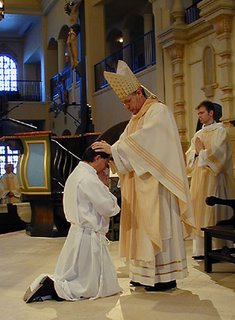"The Ministry of Fire"
 God love the Vanguard Bishop.
God love the Vanguard Bishop.Marking the feast of Our Lady of Guadalupe, Bishop Robert Finn of Kansas City-St. Joseph ordained a transitional deacon and gave a solid homily in the process.
[The] diaconate ordination was also appropriately celebrated in the middle of the season of Advent, Bishop Finn noted.
Week by week, advent candles are lit one by one, their light increasing as the birth of the savior approaches, Bishop Finn said.
"His light floods the world," he said. "His love ignites human hearts to burn with a joyous and hope-filled love, a share in his grace and life," Bishop Finn said.
Bishop Finn told Deacon Rogers and the congregation that the ministry of the diaconate is "a participation in the whole work of readying human hearts to welcome Jesus Christ. It is, in a real sense, a ministry of fire."
Speaking on a clear, crisp December day when the heavy Kansas City snow of two days earlier had begun to melt, Bishop Finn said that the deacon is called "to transform human hearts by introducing to them the burning furnace, the white hot transforming power of the heart of the savior aflame in love."
"We know we must contribute to the work by which the Body of Christ will be, not dead, but pulsing and beating, warm and alive, with the fire of Jesus Christ," he said.
Bishop Finn urged Deacon Rogers to "do the will of God from the heart."
"Serve the people in love and joy as you would the Lord," he said. "Since no one can serve two masters, look upon all defilement and avarice as serving false gods."
Bishop Finn told Deacon Rogers "to be chaste and beyond reproach before God and man, as is proper for a minister of Christ and a steward of God's mysteries."
"You will exercise your ministry committed to the celibate state," he said. "Know that celibacy is both a sign of pastoral charity and an inspiration to it, as well as a source of spiritual fruitfulness in the world."
The ordination was held at Visitation Church -- a recently-dedicated structure in Kansas City built in a Spanish Baroque style... It's luxe.
Elsewhere in the (now happily McBrien-free) Catholic Key, the bishop offers a few thoughts on the 40th anniversary of Vatican II's close, coming from the "continuity" school.
It has sometimes been suggested that in Vatican II the Catholic Church attempted to be attuned to the modern age. This seems most true to the extent that it is seen to indicate the church's obligation to influence and evangelize the modern world by bringing to it a living faith. The Second Vatican Council could never be seen as an instrument for "softening" the demands of the Gospel of Jesus Christ, particularly as regards the moral law - so that they are somehow more palatable to people of the world today.
The role of the lay faithful was affirmed in a positive and beautiful way in the council, most profoundly in chapters four and five of the Dogmatic Constitution on the Church, and the Decree on the Apostolate of the Laity. All the faithful must be engaged in the work of growing holy in Jesus Christ, and subsequently to be participants in the transformation of the culture around us. We do this when we steadfastly live our faith in all the everyday circumstances of our life in a joyous and holy way, even if it means rejection or suffering in imitation of Jesus Christ.
The council affirmed that the teaching office of the church, embodied in the pope and those bishops in union with him, has the guarantee of authenticity. The role of the theologian is at the service of the church, to give helpful expression to the church's teachings.
When studying the council's teachings, there is a hierarchy within the different documents that is worth noting. The most weighty documents are the two dogmatic constitutions: on the church and on divine revelation. Following these in importance are the two other constitutions: on the Liturgy and on the Church in the Modern World. The next documents in importance would be those entitled "decrees," in which the council intended to apply what was taught in the constitutions. Finally there are those documents called "declarations."
A fruitful approach to understanding the council a generation later would be to read the texts in this order, and use the Catechism of the Catholic Church as a guide to their application.
The Documents of Vatican II were written in continuity with the church's history and tradition. They are best studied with due respect for their full context, complexity and nuance. Such careful and prayerful study, while demanding, has tremendously rich rewards.
There's some great goodness in that thar diocese.
-30-

<< Home